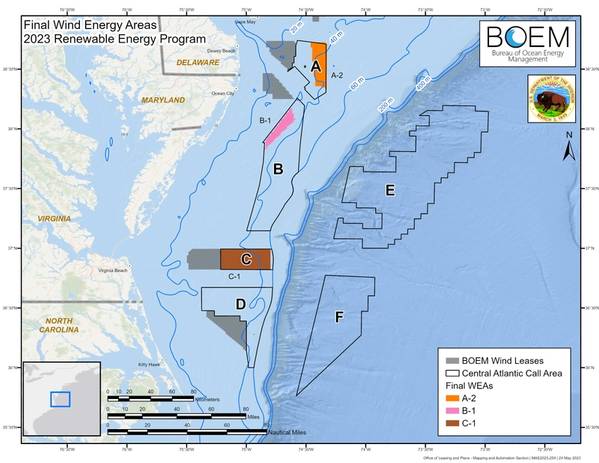
The U.S. Bureau of Ocean Energy Management (BOEM) on Monday announced three final Wind Energy Areas (WEAs) offshore Delaware, Maryland, and Virginia.
These areas, BOEM said, were developed following extensive engagement and feedback from states, Tribes, local residents, ocean users, federal government partners, and other members of the public.
If fully developed, the final WEAs could support between four and eight gigawatts of energy production. The Biden administration has a goal of deploying 30 gigawatts (GW) of offshore wind energy capacity by 2030.
The three WEAs total approximately 356,550 acres. The first WEA (A-2) is 101,767 acres and located 26 nautical miles (nm) from Delaware Bay. The second WEA (B-1) is 78,285 acres and about 23.5 nm offshore Ocean City, Md. The third WEA (C-1) is 176,506 acres and located about 35 nm from the mouth of the Chesapeake Bay, offshore Virginia.
“BOEM values a robust and transparent offshore wind planning process, which requires early and frequent engagement with Tribal governments, the Department of Defense, NASA, other government agencies, and ocean users,” said BOEM Director Liz Klein. “We will continue to work closely with them, and all interested stakeholders, as we move forward with our environmental review.”
BOEM will publish its Notice of Intent to Prepare an environmental assessment of potential impacts from offshore wind leasing in the WEAs in the Federal Register on August 1, 2023, which will initiate a 30-day public comment period. Another public comment period would occur if BOEM decided to move forward with a lease sale in any of the WEAs.
After BOEM made the announcement on the three new offshore Wind Energy Areas (WEAs), National Ocean Industries Association (NOIA) President Erik Milito said: "With offshore wind opportunities on the rise, the states along the Central Atlantic coast are positioned to become key players in the next wave of offshore wind hubs.
"The benefits of this development extend beyond the local level, with significant advantages rippling across our nation. Offshore wind is a national endeavor, and as more offshore wind leases are secured and new American offshore wind projects diversify geographically, the national supply chain stands to reap even greater rewards.
"We encourage BOEM to continue their progress in expanding offshore wind opportunities, including in areas along the mid-Atlantic. NOIA successfully advocated for language in the Inflation Reduction Act to overturn the 10-year moratorium on offshore wind leasing in the area stretching from North Carolina down through the Eastern Gulf of Mexico.
"Additionally, last year's remarkable $315 million Carolina Long Bay offshore wind lease sale highlights the region's appeal for offshore wind investments. The momentum for offshore wind is undoubtedly growing in a rising number of coastal states. Policymakers should seize this opportunity through continued offshore wind leasing, including future lease sales along the mid- and Central Atlantic."